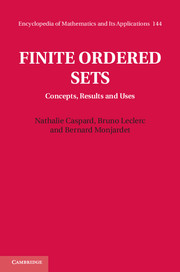Book contents
- Frontmatter
- Contents
- Preface
- 1 Concepts and examples
- 2 Particular classes of ordered sets
- 3 Morphisms of ordered sets
- 4 Chains and antichains
- 5 Ordered sets and distributive lattices
- 6 Order codings and dimensions
- 7 Some uses
- A About algorithmic complexity
- B The 58 types of connected ordered sets of size at most 5
- C The numbers of ordered sets and of types of ordered sets
- D Documentation marks
- References
- List of symbols
- Index
D - Documentation marks
Published online by Cambridge University Press: 05 February 2012
- Frontmatter
- Contents
- Preface
- 1 Concepts and examples
- 2 Particular classes of ordered sets
- 3 Morphisms of ordered sets
- 4 Chains and antichains
- 5 Ordered sets and distributive lattices
- 6 Order codings and dimensions
- 7 Some uses
- A About algorithmic complexity
- B The 58 types of connected ordered sets of size at most 5
- C The numbers of ordered sets and of types of ordered sets
- D Documentation marks
- References
- List of symbols
- Index
Summary
As already said, the study of ordered sets has long been almost exclusively devoted to that of lattices. Things started to change in the 1970s and, since then, hundreds of papers have been concerned with other ordered sets, in particular with finite ones. It would therefore require several copious books to describe just the principal results obtained in this field (in comparison, the “Handbook” on Boole algebras published by Elsevier in 3 volumes has 1440 pages). However, with regard to books, the situation has not changed much. Whereas there exist dozens of books on lattice theory, the number of books on ordered sets is still very low and the latter are often concerned with particular aspects. That is why we have given, in the last section of each chapter, a number of notions and important results, referring the reader to the (numerous) references allowing us to know more on these subjects. Below, we give some marks and indications to help the reader find his bearings among these references and, more generally, in the documentary resources of the field.
Internet and the inescapable Google
If we ask that search engine, for instance, for “partial order dimension,” we obtain almost 14 million answers, with many appropriate references in the first pages. It is then clear that Google may be a very efficient tool, even though important – but old – references may not be found.
Information
- Type
- Chapter
- Information
- Finite Ordered SetsConcepts, Results and Uses, pp. 290 - 295Publisher: Cambridge University PressPrint publication year: 2012
